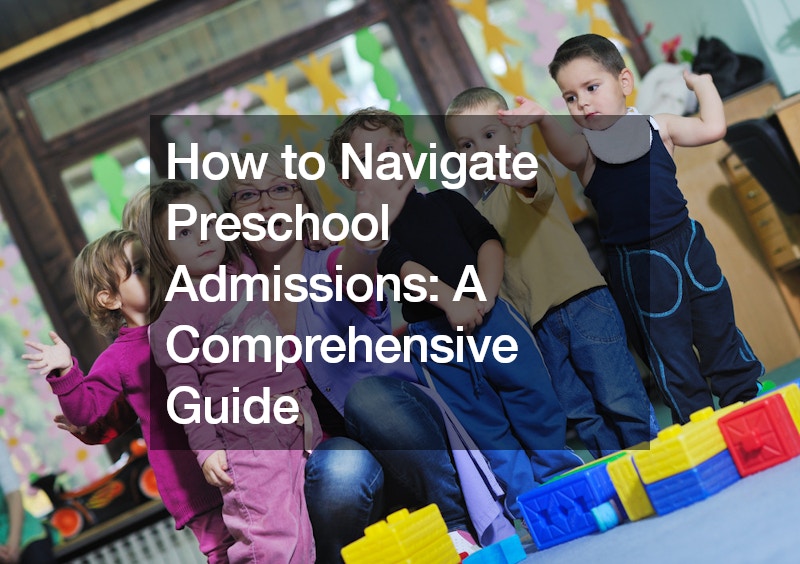
The United States boasts a diverse landscape of preschool options, each with its own philosophy, curriculum, and approach to early childhood education. For many parents, navigating the preschool admissions process can feel like entering a new world. This comprehensive guide equips you, the parent, with the knowledge and tools to confidently approach preschool selection and admissions for your little one.
Understanding Your Priorities and Child’s Needs:
Before diving headfirst into researching schools, take a step back and consider your family’s unique needs and your child’s individual development. Here are some key questions to ponder:
Philosophy and Curriculum: Explore preschool philosophies like Montessori, Waldorf, or play-based learning. Identify an approach that aligns with your values and your child’s personality and learning style. Location and Schedule: Preschool proximity to your home and work plays a big role. Consider the program schedule – full-day, half-day, or a specific program length that accommodates your work requirements and childcare needs. Facility and Environment: Look for a safe, clean, and stimulating environment with adequate indoor and outdoor play space. Class size and student-teacher ratio are crucial factors. A smaller ratio often translates to more individualized attention for your child. Cost and Financial Aid: Preschool programs vary significantly in cost. Research tuition fees and explore any financial aid options available through the school or government programs. Extracurricular Activities: While not essential, some preschools offer music, art, or foreign language classes. Consider these options based on your child’s interests and your budget. Researching Your Options:
Gather Information: Create a list of potential preschools in your area. Utilize online resources and recommendations from friends and family, or contact your local Department of Education for a list of licensed preschools. School Websites: Most preschools have informative websites that outline their philosophy, curriculum, and admissions process and potentially even showcase virtual tours. Review these websites thoroughly to gain a basic understanding of each school’s offerings. Social Media and Online Reviews: While not a substitute for firsthand experience, some schools maintain active social media pages showcasing their activities and environment. Online review platforms can offer additional insights from current and past parents, although it’s important to maintain a critical perspective on these reviews. Narrowing Down Your Choices:
After compiling a broader list, it’s time to focus on the most promising options. Here’s how to proceed:
Schedule School Visits: Contact the schools that seem most aligned with your needs and schedule in-person visits. This allows you to observe classrooms in action, interact with teachers and staff, and ask specific questions about the program and daily routines. Pay Close Attention to Details: During your visits, pay close attention to the overall atmosphere, teacher-student interaction, and the level of engagement among the children. Observe the learning materials and resources available, and don’t hesitate to ask about the school’s approach to discipline, communication with parents, and policies on outdoor play or screen time. Gather Parent Feedback: Talk to other parents whose children attend the schools you’re considering. Their firsthand experiences can offer valuable insights into the school’s strengths and weaknesses. The Application Process:
Application Deadlines: Preschool admissions often follow specific timelines. Be mindful of application deadlines and ensure you submit all required documents well in advance, including basic information about your child and potential immunization records. Some schools might request additional documents like developmental evaluations or teacher recommendations. Interviews and Assessments: Some preschools include interviews with parents or guardians as part of the application process. There might also be assessments to gauge your child’s social and developmental level to ensure readiness for the preschool environment. Making the Final Decision:
Once you’ve received admission offers from various schools, carefully weigh the pros and cons of each option. Consider your initial priorities, your child’s temperament and learning style, and the overall " gut feeling you have about each school culture and environment. Don’t be afraid to revisit schools or seek further clarification from the staff if needed. Ultimately, the goal is to choose a preschool that feels like the perfect fit for both your child and your family.
Additional Tips:
Start Early: The preschool admissions process can be competitive, especially for popular schools. Start researching options well in advance, ideally when your child is around 18 months old. Trust Your Instincts: While gathering information and recommendations is important, don’t overlook your intuition. Choose a school environment that feels comfortable and nurturing and fosters a love for learning for both you and your child. Open Communication: Maintain open communication with the preschool staff throughout the process. Ask questions, voice your concerns, and express your expectations for your child’s preschool experience. This open dialogue can create a positive and collaborative relationship between you and the school. Prepare Your Child: As the start date approaches, gently prepare your child for the transition. Talk about the new environment, routines, and making new friends. Read books about preschool and role-play scenarios like playtime or separation anxiety. Beyond Admissions: Remember, preschool admissions are just the first step in your child’s educational journey. Develop a strong partnership with the chosen school, attend parent-teacher conferences, and actively participate in school events. This ongoing collaboration fosters a supportive learning environment for your child. Conclusion:
Navigating preschool admissions in the US can be an exciting yet daunting process. By prioritizing your needs, researching thoroughly, and actively engaging in the selection process, you can ensure a smooth transition for your child as they embark on their educational journey. The ideal preschool fosters a safe, stimulating, and nurturing environment where your child can blossom intellectually, socially, and emotionally. With this comprehensive guide as your roadmap, you’re well-equipped to navigate the preschool admissions process with confidence and choose the perfect learning environment for your little one.
.




